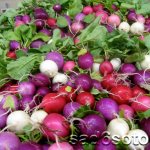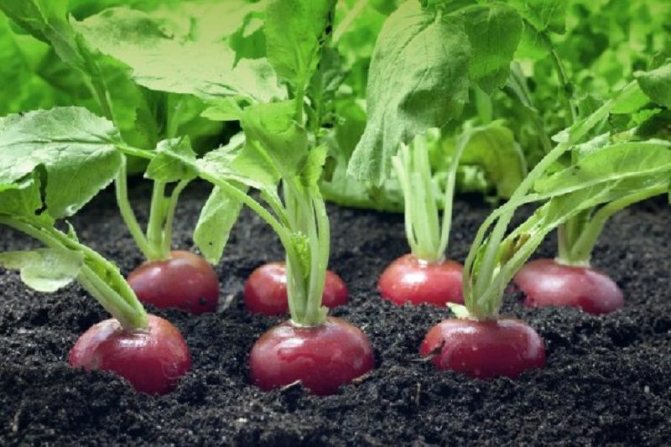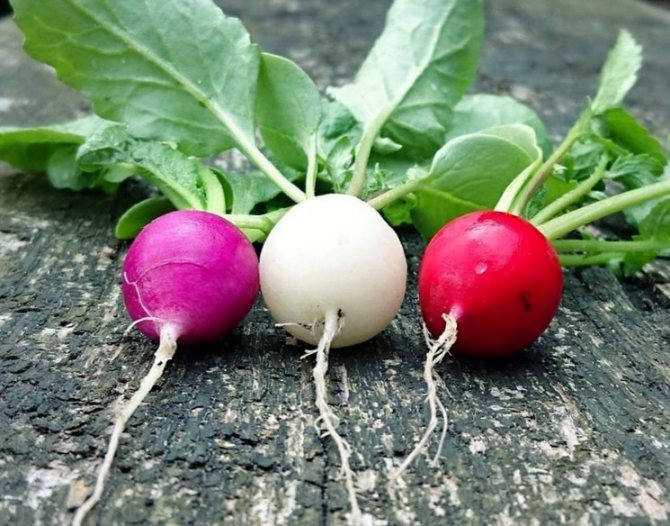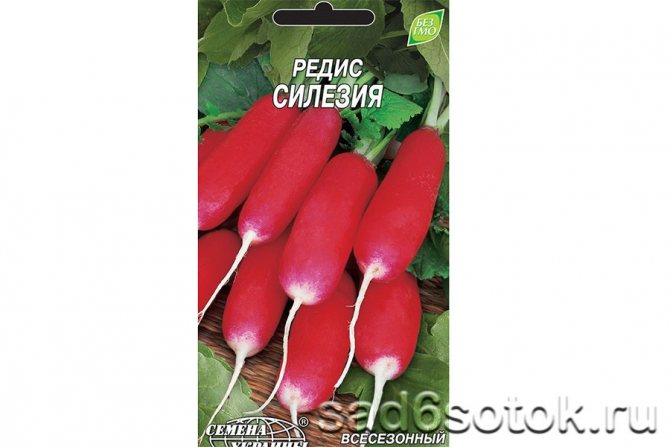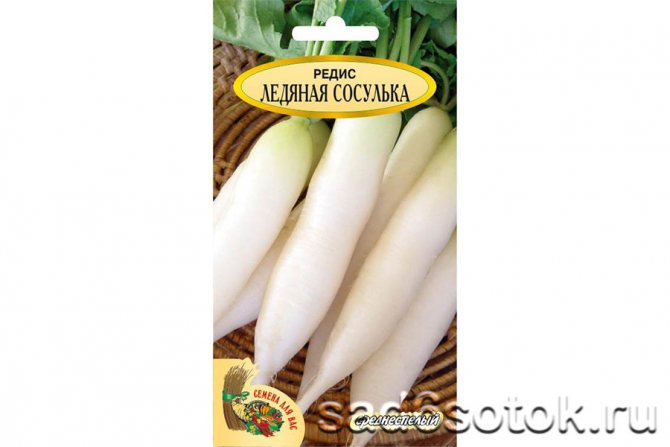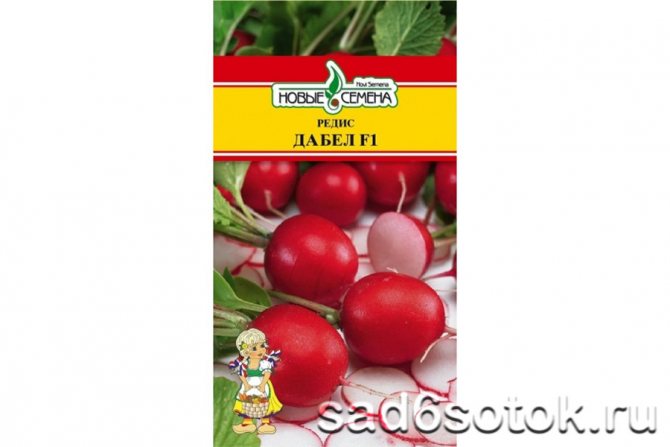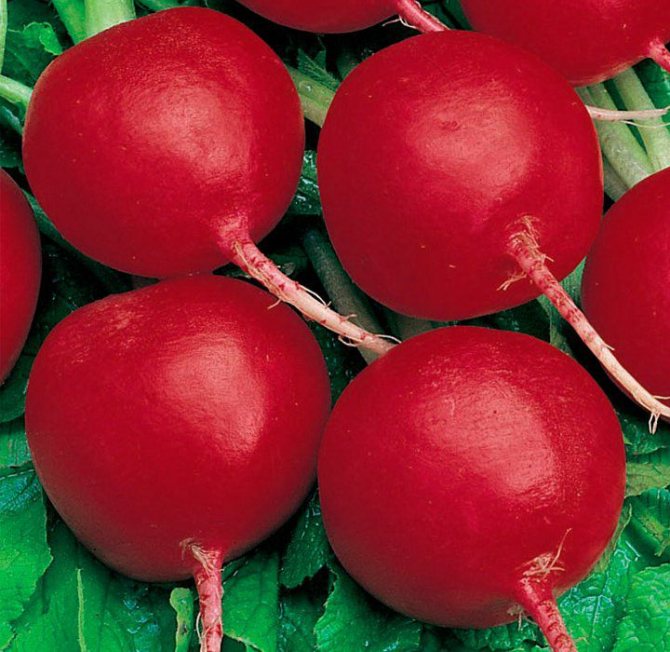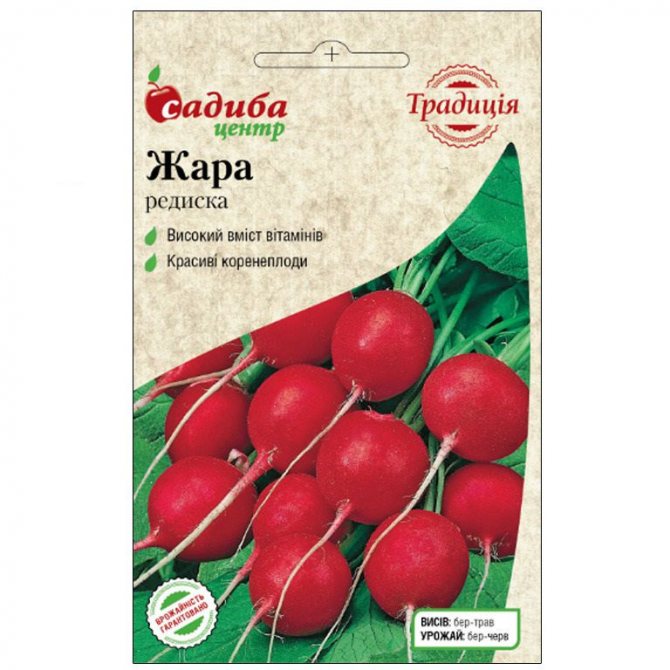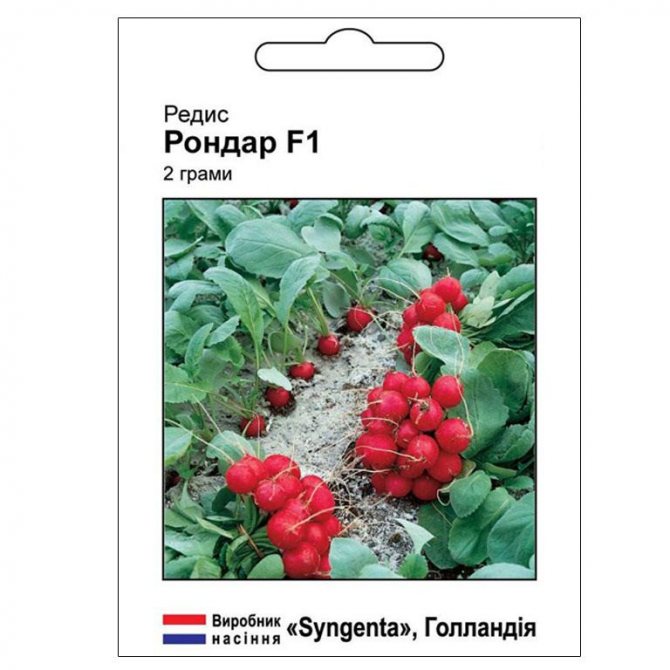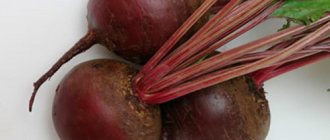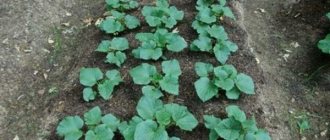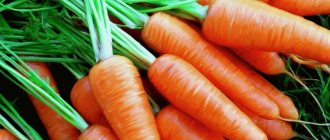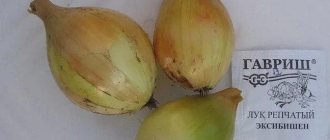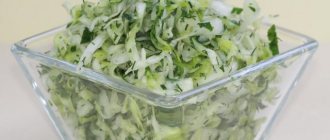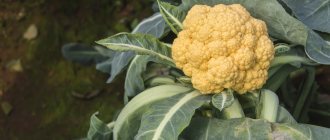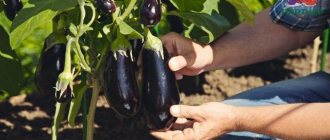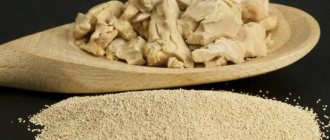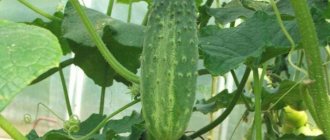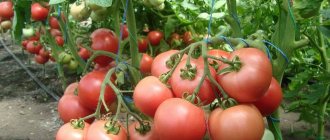Variety of radish varieties
The popular vegetable heralds the arrival of spring days, it is an indispensable product for spring salads and cold soups. The juicy pulp is rich in vitamins, minerals, and, in addition, has antimicrobial effect.
Unpretentious compact radish plants are successfully grown in the northernmost regions, and numerous varieties and hybrids are striking in their diversity, differ in maturity, size and shape, skin color and taste.
Radish Celeste F1
The Celeste F1 radish is a hybrid representative of its class, owned by Dutch breeders. The plant is considered unpretentious and fairly high-yielding - during the season, you can collect 3-3.5 kilograms of harvest from 1 square meter. The diameter of the fruit is about 5 centimeters. The taste is soft, with a slight bitterness. Celeste F1 is easy to transport.
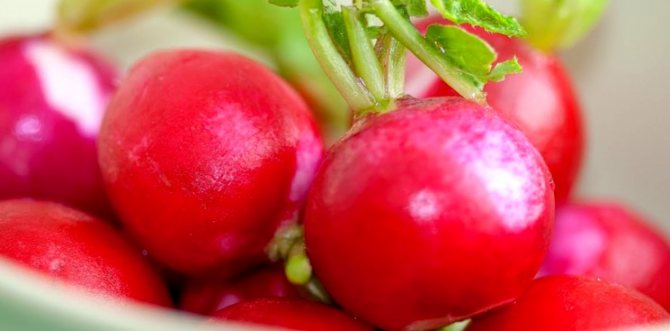
The ripening period of Celeste is 25 days from the moment the first shoots appear. This variety is moderately light-requiring and is excellent for growing both in greenhouse conditions and in the open field.
Radish variety Octava
Octave is an unusual type of radish - its fruits have the usual round shape, but are colored white. Suitable for growing in the open field and in the winter in a greenhouse. The yield of this variety varies from 2 to 2.5 kilograms per 1 square meter. The fruits are quite dense with a pleasant medium-pungent taste, most often they weigh 30-35 grams with a diameter of 3 to 4.5 centimeters.
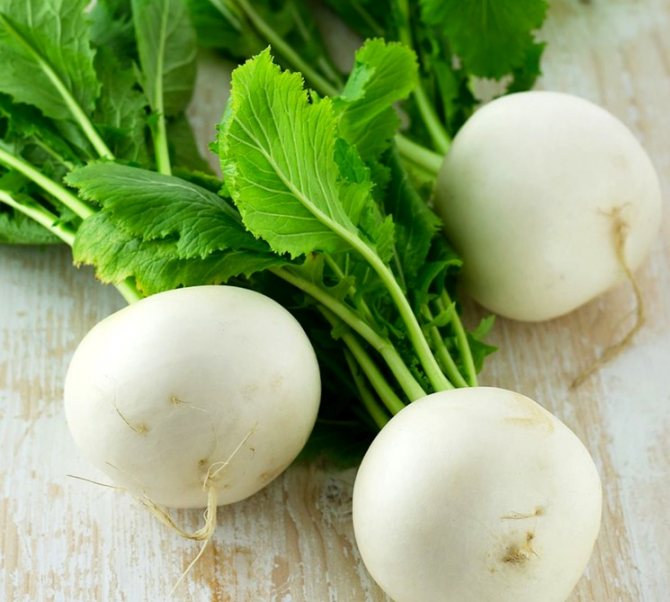

Octave belongs to varieties resistant to flowering, moderately photophilous and depends little on the length of daylight hours. The timing of sowing the seeds of this radish variety is spring sowing from April 25 to May 20, and summer sowing from August 1 to 30. The harvest time is from May 20 to July 1 and from September 1 to 20, respectively. It is sown according to the scheme 15-20 x 3 centimeters. Stored well.
Soil preparation
If something has already grown in the greenhouse in the previous season, compulsory preparation is required. After all, the soil is significantly depleted by the previous "tenants" (tomatoes, cucumbers or herbs). In order to provide future radishes with due care, the soil requires replenishment of the supply of nutrients.
To prepare you will need:
- remove all remnants of roots and branches from past plantings;
- dig up the bed, adding 3 kg each. humus per 1 sq. m. area;
- it is also recommended to feed the earth with ash (0.5 cups) or potassium sulfate mixed with urea and superphosphate (1 tablespoon of each preparation).
After the soil is ready, it is leveled with a rake and shallow grooves are made at a distance of 10 cm from each other.
Potassium sulfate prices
Potassium sulphate
Sora radish
Sora radish is an excellent early Dutch variety, the main advantage of which is good resistance to high summer temperatures and direct sunlight. The fruits have a classic round shape, bright red color and quite juicy pulp with a pleasant medium-bitter taste, each root vegetable weighs an average of 25 grams.
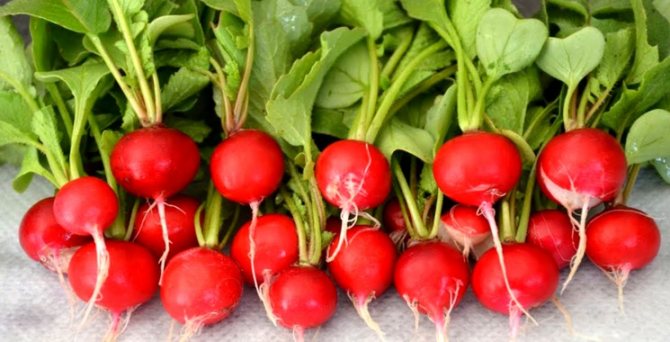

Sowing dates for Sora begin in March and can be done until early autumn. The variety does not arrow. Due to its biological qualities, such a radish is perfectly cultivated both in greenhouses and in the open field.
Würzburg 49
Medium late type of Russian selection. The crop ripens on the fortieth day after sowing the seeds. This culture is highly resistant to disease.The fruits are red, large, contain tasty and very juicy, crunchy flesh without a pungent taste.
Due to its high yields and the ability to grow in different climatic conditions, this variety is grown in many countries.
Most of these varieties can also be grown in a greenhouse, as we wrote in this article.
Duro radish variety
Another good radish variety suitable for both outdoor and greenhouse cultivation. Duro has bright red, round and uniformly smooth fruits with fine skin and pleasant taste. The sowing time can be considered unlimited, and since the fruits ripen quite large - up to 5 centimeters in diameter - sowing should be done with a "step" of 10 centimeters.
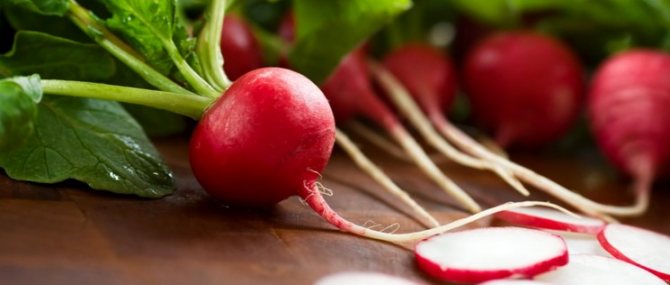

This variety is considered disease-resistant, seedlings and fruits develop and ripen quickly enough. Plus, the Duro radish is well stored and tolerates transportation well. Does not dry out and retains its taste and juiciness for a long time.
Radish Diego
Diego radish is an unpretentious and at the same time early maturing variety - another representative of the Dutch selection. Its distinctive feature and one of its main qualities is size. Ripe fruits can weigh up to 65-70 grams each. Accordingly, its yield is also high, and about 3 kilograms of radish can be obtained from one square meter of land.
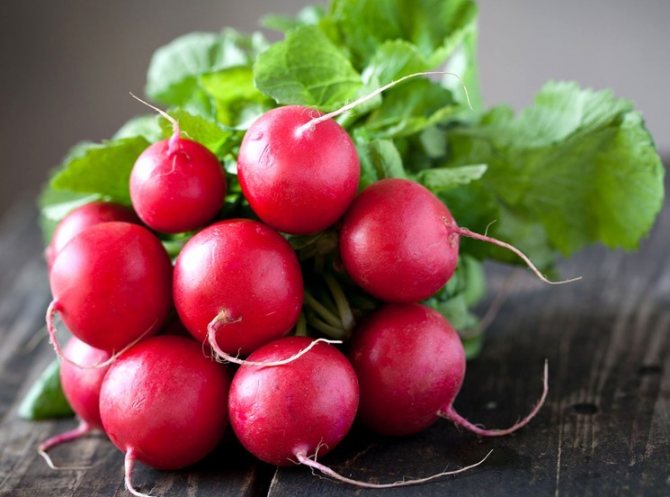

The timing of sowing seeds of this variety of radish varies from spring to autumn, it depends on the method of cultivation. It feels great both in the greenhouse and in the open field. Ripening time from 20 to 30 days from the moment the first shoots appear.
Cooking methods
There are many different recipes and methods for preparing dishes from radish or with its addition. The product is able to combine well with various vegetables in salad compositions. The root crop is rarely subjected to heat treatment.
Did you know? Japanese chefs make chips
from radish: The fruits are cut into thin strips and dried in an oven. Such a snack can last for a very long time, especially when packed in paper or in a glass container.
Here are some dishes you can add radishes to:
- spring salads with the addition of various greens, seasoned with sour cream or mayonnaise;
- vegetable salad with the addition of goat cheese or feta cheese;
- salad with eggs and cucumbers;
- chicken salad;
- salad with cabbage and corn;
- dandelion, lettuce and sorrel salad;
- okroshka on kvass or kefir;
- sandwiches;
- cold vegetable soups;
- beetroot;
- various meat and fish canapes;
- salad of green beans, tomatoes and feta cheese;
- curd pate;
- squid salad;
- Russian salad;
- borsch with sorrel;
- liver cake;
- stuffed root vegetable (for large varieties) with various fillings.
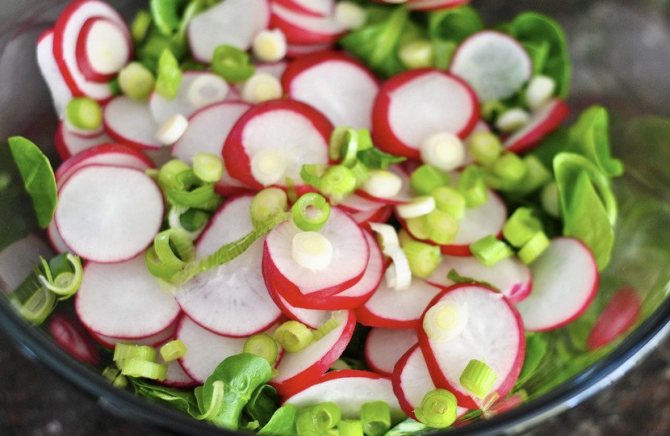

Radish is rightfully called the first vitamin doctor, which is difficult for our body to do without in spring. But you also need to use it in moderation and carefully, since the product has its own contraindications. To be sure that everything is in order for you, consult with your doctor - this will help to correctly apply vitamin therapy with radish and warn you against negative consequences.
Deca radish
Deca radish is early maturing, more suitable for greenhouses. Root crops have very good taste, smooth, red with a rich pink tint. Fruits ripen up to 5 centimeters in length and up to 3.5 centimeters in diameter, the average weight of each is from 11 to 13 grams. The color of the juicy pulp can be either white or pinkish.
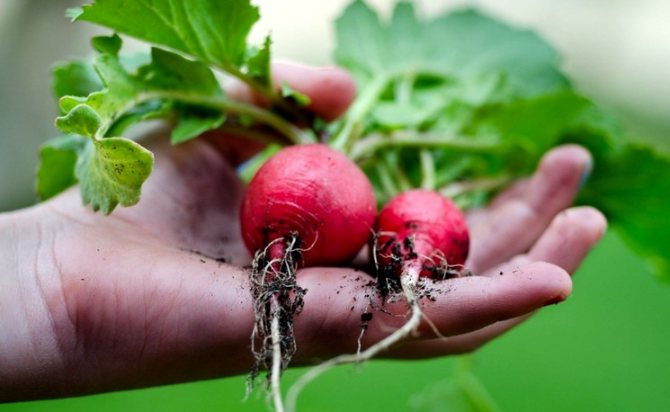

As for the sowing time - in the open ground this is April, and in the greenhouse at your discretion. The yield of Deca radish differs from the growing conditions, so, for example, in a winter greenhouse from 1 square meter, you can collect about 2 kilograms of fruit, and in a film one almost twice as much - up to 4 kilograms.The period of fruit ripening itself is from 20 to 30 days - from the moment of full germination.
Late ripening
Late-ripening varieties ripen 35 or more days after planting. They are preferably planted in late spring or early summer.
Ice icicle
Differs in the following characteristics:
- the length of vegetables can reach 20 cm with a weight of 50 g;
- the skin has a pleasant white color;
- the pulp is crispy, juicy, almost without bitterness;
- resistant to many diseases and low temperatures;
- there is a low yield of the variety.
It ripens finally within 40 days.
Dungan 12/8
- fruit diameter - about 7 cm, weight - within 75 g;
- the skin is reddish;
- the pulp is firm, juicy, with a pleasant taste;
- suitable for long-term storage;
- has a high yield.
Under good conditions, it ripens within 48 days.
White Fang
- fruits are elongated;
- radish reaches 12 cm in length and 24 g by weight;
- the skin is white;
- contains a large amount of vitamins;
- resistant to many diseases.
Fully ripens after 40 days.
Autumn giant
Pay attention to:
- fruits are large, their weight can reach 140 g, and their diameter is 6 cm;
- the length of vegetables, it can be about 9 cm;
- snow-white color of the skin;
- suitability for long-term storage;
- tart taste with hints of bitterness.
Ripening period is about 40 days.
Red giant F1
The signs of a hybrid include:
- fruits can reach 17 cm in length;
- 1 radish can weigh up to 120 g;
- leaves are suitable for making salad;
- suitable for long-term storage;
- resistant to temperature changes and many diseases.
The ripening period ranges from 50 days.
White icicle
One of the most unusual, in appearance, varieties of radish. Outwardly, "White Icicle" is very similar to such a root vegetable as daikon - Japanese or Chinese radish. Several other varieties of radish also have such an oblong shape, for example, "Firefly", "Ice Icicle" and others. The pulp of such a radish is white, rather juicy and slightly spicy.
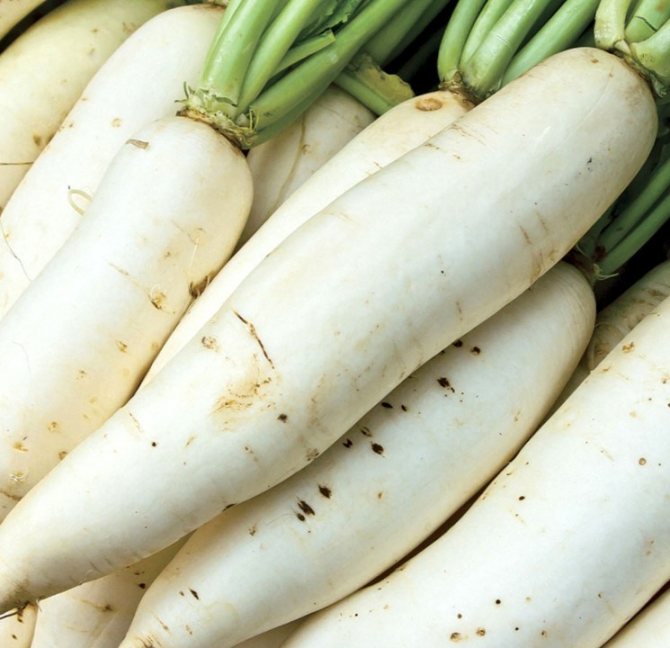

The variety is considered late-ripening - the period from germination to harvest is from 28 to 32 days. Cultivation terms - from early spring to early autumn. The fruits are elongated and reach 15 centimeters in length, with an average weight of 20 grams each. The variety is suitable both for cultivation in winter greenhouses and for open ground. The yield of the "White Icicle" is from 3 to 3.5 kilograms per square meter.
Diseases and pests
Radish rarely gets sick. The most common illnesses include:
- White rot. With it, the wateriness of the pulp of the vegetable is observed, the red color is lost, the root crop is covered with a bloom of white.
- Gray rot. The radish stored in the refrigerator is affected.
- Powdery mildew. It affects the development of leaves. A white coating appears on their upper side, which then acquires a brown tint. Leaves wilt, which is bad for the growth of radishes.
- Radish mosaic. This is a viral disease. It inhibits the growth of the root crop, deforms the leaves.
- Blackening of roots. With this disease, dark spots appear at the root. They can also be observed on the fetus itself. This leads to rotting of the vegetable.
Pests that disrupt the normal development of radishes include:
- cabbage butterfly;
- cabbage moth;
- flea;
- spring and summer cabbage flies;
- clickers and so on.
To prevent diseases and control pests, radishes are prophylactically pollinated with ash or tobacco dust. It will also protect you from diseases and early sowing of radishes, since hot weather contributes to diseases. Specific ways to deal with the onset of the disease are described in another article on our website.
French breakfast
French breakfast is an early ripe, rather unpretentious variety of radish, the fruits of which are slightly elongated, one might say, oval.Root vegetables "breakfast" grow from 5 to 8 centimeters in length and weigh an average of 20 grams. As for the palatability, the white-pink, rather juicy pulp has a very delicate taste with a slight bitterness. By the way, this variety can also boast of delicious greens - the tops of the French Breakfast are often eaten like fresh salad greens.
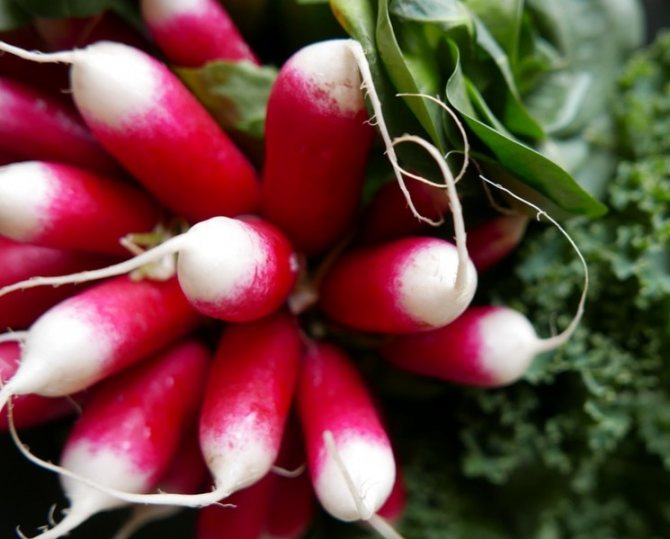

Due to its unpretentiousness, this variety is cultivated both in greenhouses and in open ground, where, we recall, the seeds of this radish are sown very early. The ripening time is approximately 25 days from the moment of full germination to harvest.
Radish "18 days"
Radish "18 days" is an early ripening variety with a very delicate taste of root vegetables, practically without bitterness, as in the case of the aforementioned "French breakfast", green tops of radish are also eaten. Cylindrical fruits, red-pink with white tips, reach a mass of 20 to 25 grams.
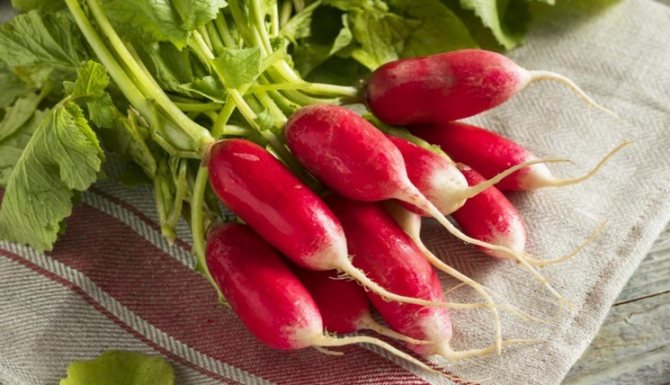

Radish variety "18 days" is suitable for growing in the open field and in greenhouses, due to the short maturation period, which is 18-20 days from the moment of full germination. This makes it possible to sow seeds of this variety and harvest more than once a season. To get early harvests, it is worth starting sowing at the very beginning of March, and early September is suitable for planting radishes in autumn.
Homemade root vegetable cosmetics
As already mentioned, radishes are good for the skin. But besides the treatment of dermatitis and eczema, it can improve the complexion of the skin. Vegetable juice moisturizes dry skin well, and radish gruel masks make it soft and velvety. The tonic made from radish, cucumber and parsley juice will lighten freckles and age spots. For oily skin, a mask made from grated root vegetables and milk is suitable. A nourishing mask made of starch, olive oil and gruel from a raw vegetable will help refresh your face after winter frosts.
Important note: When using homemade radish cosmetics, you need to protect your eyes from vegetable juice.
Radish Heat
One of the most popular varieties of radish in our country is the "Heat" variety - an early maturing and very productive root crop. Round in shape, red or deep crimson in color. Each weight varies from 17 to 26 grams. "Heat" boasts a very juicy, dense and tasty pulp, with a slight pungency.
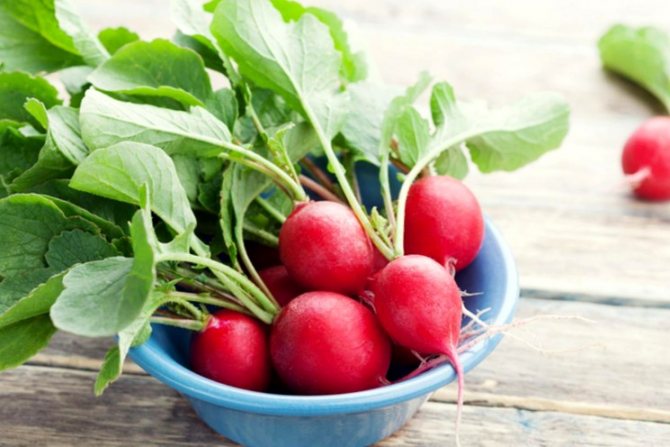

The list of the main advantages of this variety includes its resistance to heat, which is guessed in the name, and resistance to many diseases, as well as to flowering. Radish "Heat" loves pre-fertilization of the soil. The timing of ripening also delights gardeners - from the appearance of full shoots to harvest: from 20 to 25 days. Depending on the cultivation method, the yield varies from 1 to 2.5-3 kilograms.
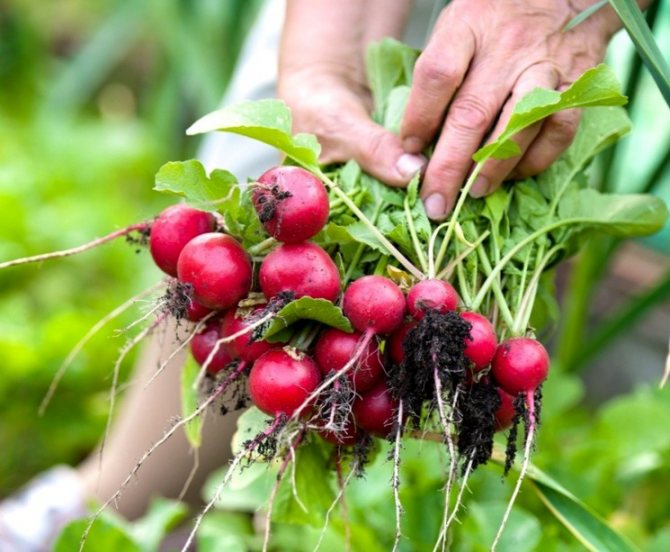

Among all the root vegetables that we have introduced into our menu a long time ago, such as radish, potatoes or beets, radish is probably the most beloved. Well, first of all, it appears on our beds and on store shelves as one of the very first fresh vegetables. Secondly, you don't have to "cook" it - just cut it into a salad or eat it washed up just like that. Well, and, of course, we value radishes for the nutrients and vitamins in its composition, which we need so much after a long winter.
There are a great many varieties of this wonderful vegetable, which differ not only in the degree of bitterness or juiciness of the fruit, but also in shape, size and color. Radish can be white, pink, red, two-color, and even purple. Each representative of the radish varietal range has its own terms of germination and ripening, many can be grown several times in one season. Here we discussed varieties that grow and bear fruit equally well in greenhouses and outdoors.
Description of the plant
Radishes began to be grown and used in cooking as early as 3 thousand years BC. The history of the root crop in Europe begins in the 16th century.It comes from a related plant, the seaside radish, which has been successfully used in agriculture in the Mediterranean countries.
Radish varieties are divided into European, Chinese and Japanese. In Russia, it is customary to breed European varieties. Breeder E.A. Grachev in the 19th century bred special types of radish that take root well in the cold climate of the northwest. The scientist's business was continued by his son V.E. Grachev. At the beginning of the 20th century, he managed to get his own varieties of root crops for the conditions of Russia, but, unfortunately, times were difficult - war, revolution, and most of his work was lost.
The appearance of the vegetable is well reflected in the picture. The root crop grows in moist fertile soil or in a greenhouse. Some housewives grow it at home.
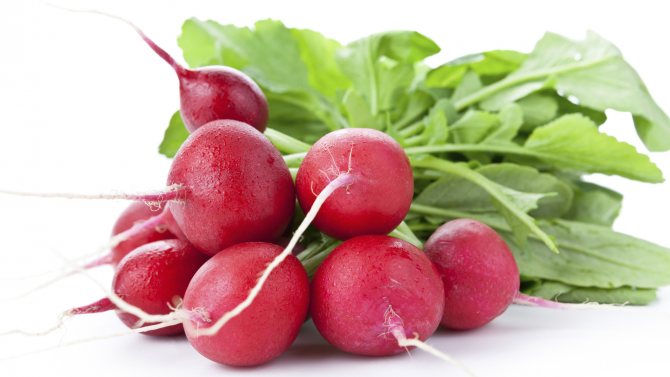

Radish externally is a small solid ball or cylinder of red or dark pink color
The benefits of a vegetable are due to the high content of vitamins and minerals in it. The radish includes vitamins A, E, group B vitamins, vitamins C and PP. Of the minerals, the root crop is rich in calcium and potassium, iron, phosphorus, magnesium. Doctors recommend red radish for use in case of diabetes mellitus, gout, intestinal dysbiosis and other pathologies.
Various salads are prepared from the vegetable. A popular salad with herbs and a boiled egg with the addition of radish. The root crop is often subjected to heat treatment - it is stewed, fried, baked. There are many recipes for radish.

